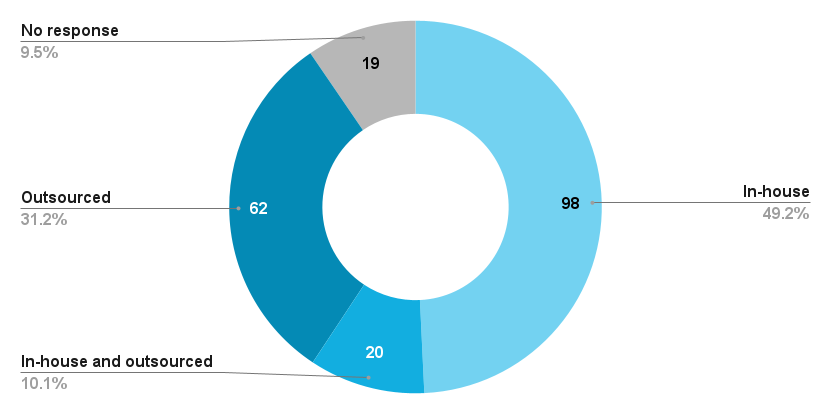Nearly half (98; 49.2%) of the respondents rely solely on in-house infrastructure, almost one-third use outsourced services (62; 31.2%), while about 10.1% combine various in-house and outsourced resources.
| Technical maintenance | # journals | % journals |
|---|---|---|
| In-house | 98 | 49.2% |
| In-house and outsourced | 20 | 10.1% |
| Outsourced | 62 | 31.2% |
| No response | 19 | 9.5% |
| Total | 199 | 100.0% |
Figure 10. Maintaining and updating a journal’s technical infrastructure
Most journals (138; 69.3%) use only one maintenance option and the survey data reveal a strong reliance on in-house IT services, which are used by almost half of the respondents (95; 47.7%).
Table 10. Provision of technical service maintenance
| Technical service maintenance | # journals using | # journals using as the only option |
|---|---|---|
| In-house by an IT department/personnel | 95 | 57 |
| In-house by a dedicated publishing department | 37 | 13 |
| In-house across different departments | 14 | 7 |
| Partially outsourced | 47 | 31 |
| Mainly outsourced | 16 | 11 |
| Fully outsourced | 23 | 19 |
Other responses include:
- AJOL
- Editor-in-chief
- In-house by two volunteers
- Mainly Personal computers are used. No specialized infrastructure is in place
- The Publisher does it, but using OJS
- The technical infrastructure is maintained & updated by volunteers of the journal
- Volunteer personnel
- We use OJS/PKP which we pay on a volunteer base; any other tech infrastructure is done on a volunteer base
For more than half of the respondents (112; 56.3%), the publishing infrastructure supports all publishing workflows online (e.g. a journal’s online platform is used to submit manuscripts, review them and make them openly available after approval for publication).
Figure 11. Online publishing workflows in publishing infrastructure
Public Knowledge Project’s open-source software Open Journal Systems is by far the most popular publishing software used in the surveyed sample (136; 68.3%).
| Software | # journals | % journals |
|---|---|---|
| Open Journals System (OJS) and OJS-based | 136 | 68.3% |
| WordPress | 14 | 7.0% |
| DSpace | 2 | 1.0% |
| Other | 11 | 5.5% |
| None or unspecified | 9 | 4.5% |
| Don't know | 27 | 13.6% |
| Total | 199 | 100.0% |
Figure 12. Software used for the publishing system
Other responses include:
- IMIST platform
- Locally developed, customized software / Our online publishing system
- Manuscript Central
- None
- Our journal is integrated in the Algerian Scientific Journal Platform which is our publishing infrastructure support online
- PUBNiTO
- ScholarOne
- Skin-the-Cat Creative Lab
Almost three quarters (148; 74.4%) of the respondents assign unique persistent identifiers. The majority of journals use only one PID (188; 54.3%) and the most commonly used is Crossref DOI. More than half of the surveyed journals (113; 56.8%) use Crossref DOI, while for 40.2% it is the only PID used. ORCID is used by 25.6% (51 journals). Other PIDs are used only sporadically.
Table 11. Persistent identifiers used by the surveyed journals
| PIDs | # journals | % journals |
|---|---|---|
| Crossref DOI | 80 | 40.2% |
| Crossref DOI, ORCID | 28 | 14.1% |
| Other DOI | 14 | 7.0% |
| ORCID | 10 | 5.0% |
| Other DOI, ORCID | 7 | 3.5% |
| DataCite DOI | 4 | 2.0% |
| Other combinations | 7 | 3.5% |
| None | 49 | 24.6% |
Table 12. The use of persistent identifiers
| PID | # journals using | # journals using only this PID |
|---|---|---|
| Crossref DOI | 113 | 80 |
| DataCiteDOI | 7 | 4 |
| Other DOI | 22 | 14 |
| ORCID | 51 | 10 |
| URN | 1 | 0 |
| ARK | 2 | 0 |



